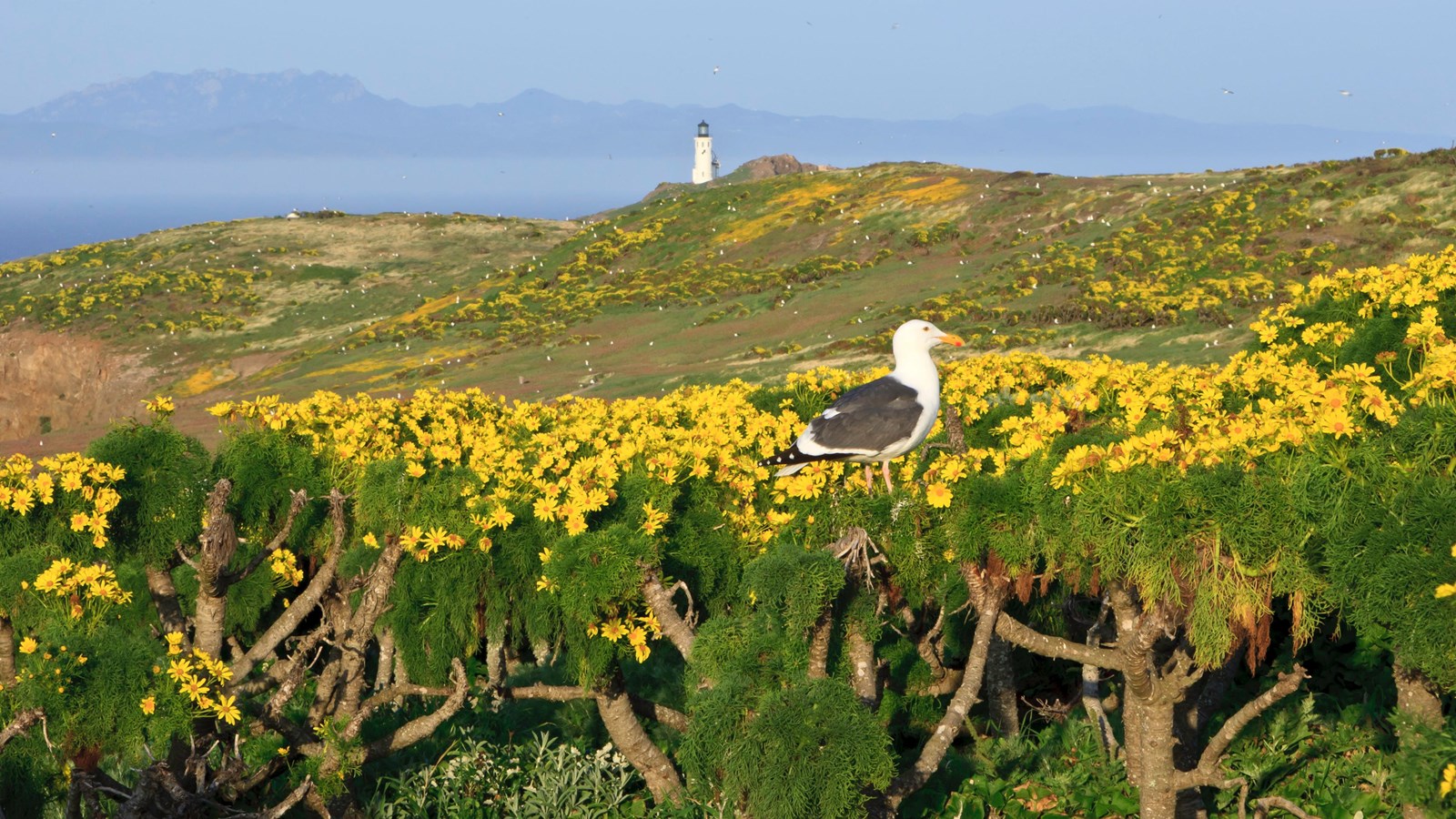Last updated: March 19, 2021
Place
Coreopsis Forest

Tim Hauf, timhaufphotography.com
Each spring Anacapa's coreopsis, or tree sunflower, undergoes a marvelous transformation. For a few brief weeks in March and April the plant's tall, bare trunks disappear beneath masses of bright green foliage with showy yellow blossoms.
Coreopsis survives the lengthy dry season-nine or ten months each year-by remaining dormant. The plant's brittle, seemingly lifeless stems are easily damaged or broken. Anacapa's isolation and the absence of large animals that might trample them protect coreopsis during this dormancy.
Native plants found in association with coreopsis include island morning glory, gumplant, Indian pink, and golden yarrow. Please be careful to stay on the designated path and not disturb or walk on the island vegetation.
Drought
The 2010s drought in California has had a huge impact on the coreopsis. Without adequate rainfall many of the islands' coreopsis has died off or been blown over in strong winds. Once the rains return, seedlings will sprout and the coreopsis forest will begin to grow again.
More Native Plants
With the islands never being connected to the mainland, plants, seeds, and spores over millions of years were carried from the mainland by ocean currents, wind, and birds or in the fur of animals that reached the islands. Due to continuous isolation from the mainland, many plant communities on the islands are unique, including the absence of some common mainland species and the presence of many island endemics (species that grow naturally only on one or more of the Channel Islands).
Since the Chumash did not practice agriculture, they used native plants as a primary source of food and medicine. Native plants also provided important construction materials for canoes, houses, bows, arrows, nets, baskets, beds, clothing, footwear, ornaments, and a variety of other items used in daily life.
With nonnative iceplant now removed, many native plants are starting to recover and reestablishing themselves throughout the island. Take time to look carefully and you should see some of the following species.
Monkey Flower
Monkey flower is common in chaparral throughout California. Known as "sticky" monkey flower because the deep green leaves secrete a gluey substance, they bloom from January to May and were named for the monkey face that sometimes can be seen within the orange to pale yellow flowers. The island endemic species differs from the mainland species in the lack of sticky leaves and its bright red flowers.
Lemonade Berry
Lemonade berry is a shrub with thick, leathery leaves. The Chumash would steep the sticky, lemon-tasting berries in water to make juice, or they would suck on them like candy. One should be careful, however, since lemonade berry belongs to the same family as poison oak and can trigger a skin rash in those sensitive to it.
Coastal Prickly Pear
The coastal prickly pear is a cactus that blooms in May and June, producing a shiny yellow flower with dense layers of petals. The plant's shallow root system spreads over a wide area to extract maximum moisture while its sharp spines reflect the sun and wind to help protect the plant from deyhydration.
The Chumash harvested the sweet prickly pear fruit and used its beet-red juice as a paint and dye. The long, sharp cactus thorns were used for decorative ear piercing and tattooing. Vertical and transverse lines were commonly tattooed on the cheeks and chin, although tattoo designs were applied also to the forehead, arms, and other parts of the body. To create a dark blue tattoo, the skin was pricked with a cactus thorn and the punctures rubbed with charcoal. When the wounds healed the pigment was sealed under the skin.
Dudleya (Live-forever)
Perhaps no plant is more versatile in adapting to different habitats than dudleya. These low-growing, fleshy succulents with a waxy coating commonly grow on dry, rocky outcroppings.
However, they also can be found on stabilized sand dunes, grasslands, and scrub habitats in conditions varying from full sun to shade. This adaptability is reflected in the variety of dudleyas found on the Channel Islands, including one species on Anacapa Island, sand-lettuce.
Wild Cucumber
Another plant that evolved to deal with the dry conditions of southern California is the vine-like wild cucumber that often can be seen along the hillsides in the oak understory. This plant has an immense, poisonous, fleshy root, or underground tuber, that stores water and nutrients.
Wild cucumber is one of the very first flowers to bloom from January to June. The plant sprawls over trees, shrubs, and the ground, leaving a tangle of dried stems and leaves by midsummer. In spring however, the wild cucumber forms large, egg-shaped, bright green fruits covered with big soft green prickles that turn hard and spiny as the fruits dry.
Inside are large seeds. The Chumash made necklaces of these seeds, polishing them along their oiled bodies. They were used also as marbles by Chumash children.
Giant Coreopsis
Each spring Anacapa's coreopsis, or tree sunflower, undergoes a marvelous transformation. For a few brief weeks in March and April the plant's tall, bare trunks disappear beneath masses of bright green foliage with showy yellow blossoms.
Coreopsis survives the lengthy dry season-nine or ten months each year-by remaining dormant. The plant's brittle, seemingly lifeless stems are easily damaged or broken. Anacapa's isolation and the absence of large animals that might trample them protect coreopsis during this dormancy.
Other Native Plant Species
Other plants to look for include giant coreopsis, scouring rush, coastal goldenbush, indian pink, island morning glory, gumplant, coastal sagebrush, and golden yarrow.
